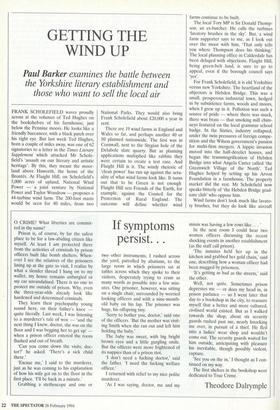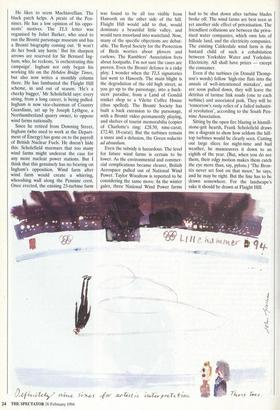GETTING THE WIND UP
Paul Barker examines the battle between
the Yorkshire literary establishment and those who want to sell the local air
FRANK SCHOLEFIELD waves proudly across at the volumes of Ted Hughes on the bookshelves of his farmhouse, just below the Pennine moors. He looks like a friendly buccaneer, with a black patch over his right eye. But last week Ted Hughes, born a couple of miles away, was one of 62 signatories to a letter in the Times Literary Supplement which attacked Mr Schole- field's 'assault on our literary and artistic heritage'. By this, they meant the moor- land above Haworth, the home of the Brontës. At Flaight Hill, on Scholefield's 5,000 acres of upland, National Wind Power — a joint venture by National Power and Taylor Woodrow — proposes a 44-turbine wind farm. The 200-foot masts would be seen for 40 miles, from two
National Parks. They would also bring Frank Scholefield about £20,000 a year in rent.
There are 19 wind farms in England and Wales so far, and perhaps another 40 or 50 planned nationwide. The first was in Cornwall, next to the Stygian hole of the Delabole slate quarry. But as planning applications multiplied like rabbits they were certain to create a test case. And Flaight Hill is it. The windy rhetoric of 'clean power' has run up against the actu- ality of what wind farms look like. It turns out that to be Green is not enough Flaight Hill sets Friends of the Earth, for example, against the Council for the Protection of Rural England. The outcome will define whether wind farms continue to be built.
The local Tory MP is Sir Donald Thomp- son, an ex-butcher. He calls the turbines 'lavatory brushes in the sky'. But,• a wind farm supporter says to me, as I look out over the moor with him, 'That only tells you where Thompson does his thinking' The local planning office in Calderdale has been deluged with objections. Flaight Hill, being green-belt land, is sure to go to appeal, even if the borough council says 'yes'.
For Frank Scholefield, it is old Yorkshire versus new Yorkshire. The heartland of the objectors is Hebden Bridge. This was a small, prosperous industrial town, hedged in by subsistence farms, woods and moors, when I grew up in it. Pollution was such a source of pride — where there was muck, there was brass — that smoking mill chim- neys featured on the local grammar school badge. In the Sixties, industry collapsed, under the twin pressures of foreign compe- tition and the Wilson government's passion for multi-firm mergers. A hippie invasion moved into the half-derelict houses, and began the transmogrification of Hebden Bridge into what Angela Carter called 'the Greenwich Village of the North'. Ted Hughes helped by setting up his Arvon Foundation in a farmhouse. The property market did the rest. Mr Scholefield now speaks bitterly of 'the Hebden Bridge grad- uate club' who oppose him.
Wind farms don't look much like lavato- ry brushes, but they do look like aircraft
propellers on stilts: an aeronautical show gone mad. They are nothing like the cosy image conjured up by the original idea of wind power — which was probably condi- tioned by childhood recollections of jolly pictures of Dutch windmills.
The main thing to remember about wind farms is that they are a racket. Like oil- seed rape, they are just a way to grow sub- sidies. The firms that build them get their hands on money from the Government's `non-fossil fuel obligation'. This is funded by a 10 per cent levy on your electricity
bill, whether you like it or not. It was invented, at privatisation, largely as a way to prop up the unsellable nuclear power industry (and last year 98 per cent of it went into these pockets). Just as electricity companies are legally obliged to buy 20 per cent of their power from nuclear sta- tions, so they are obliged to buy any wind- generated power that is produced. It is a rigged market. The Government's aim is to achieve 2 or 3 per cent of electricity from wind generation by the end of the decade. It costs at least twice the going rate.
National Power put ads in the farming press suggesting that anyone with a likely upland site should get in touch. Landown- ers could 'secure a continuing income . . . at no cost to themselves'. Frank Schole- field read this, and registered three poten- tial sites with the Department of the Environment. All farmers live with, by and for subsidies. Scholefield rears sheep, but subsidies for wool and lamb are falling. Farms in this landscape have never made big money. The industrial revolution start- ed here because it helped to have a loom as well as a flock of sheep.
With wind farms, seeing is disliking. The Green lobby has been put on the spot by government policy. Admittedly, there are some who find them objects of beauty. Sir Richard Rogers wrote to the Guardian to say that objectors showed 'a total lack of understanding and vision'. But opposition has grown as people have realised what the turbines were like. Last year, a smaller wind farm opened on a moor above Hali- fax, not far from the Scholefield farm. Mr Scholefield opposed it. He recently told the local paper that this was 'out of igno- rance'. Talking to me, he changed tack. 'It was because I had better sites.' He likes to seem Machiavellian. The black patch helps. A pirate of the Pen- nines. He has a low opinion of his oppo- nents' motives. The TLS letter was organised by Juliet Barker, who used to run the Brontë parsonage museum and has a Brontë biography coming out. 'It won't do her book any harm.' But his sharpest arrows are reserved for Sir Bernard Ing- ham, who, he reckons, 'is orchestrating this campaign'. Ingham not only began his working life on the Hebden Bridge Times, but also now writes a monthly column there. He has lambasted the Flaight Hill scheme, in and out of season. 'He's a cheeky bugger,' Mr Scholefield says: every string, from a long career, is being pulled. Ingham is now vice-chairman of Country Guardians, set up by Joseph Lythgoe, a Northumberland quarry owner, to oppose wind farms nationally.
Since he retired from Downing Street, Ingham (who used to work at the Depart- ment of Energy) has gone on to the payroll of British Nuclear Fuels. He doesn't hide this. Scholefield murmurs that too many wind farms might undercut the case for any more nuclear power stations. But I think that this genuinely has no bearing on Ingham's opposition. Wind farm after wind farm would create a whirring, whooshing wall along the Pennine crest. Once erected, the existing 23-turbine farm
was found to be all too visible from Haworth on the other side of the hill. Flaight Hill would add to that, would dominate a beautiful little valley, and would turn moorland into wasteland. Now, many of the specific objections are debat- able. The Royal Society for the Protection of Birds worries about plovers and curlews. The Ramblers' Association frets about footpaths. I'm not sure the cases are proven. Even the Brontë defence is a risky ploy. I wonder when the TLS signatories last went to Haworth. The main blight is the degradation of the old high street, as you go up to the parsonage, into a huck- sters' paradise, from a Land of Gondal trinket shop to a Vilette Coffee House (thus spelled). The Brontë Society has built a back extension to the parsonage, with a Brontë video permanently playing, and shelves of tourist memorabilia (copies of Charlotte's ring: £28.50, nine-carat; £72.40, 18-carat). But the turbines remain a snare and a delusion, the Green reductio ad absurdum.
Even the subsidy is hazardous. The level for future wind farms is certain to be lower. As the environmental and commer- cial complications became clearer, British Aerospace pulled out of National Wind Power. Taylor Woodrow is reported to be considering the same move. In the winter gales, three National Wind Power farms had to be shut down after turbine blades broke off. The wind farms are best seen as yet another side effect of privatisation. The friendliest collusions are between the priva- tised water companies, which own lots of hillside land, and the electricity companies. The existing Calderdale wind farm is the bastard child of such a cohabitation between Yorkshire Water and Yorkshire Electricity. All shall have prizes — except the consumer.
Even if the turbines (in Donald Thomp- son's words) follow 'high-rise flats into the annals of well-intentioned mistakes', and are soon pulled down, they will leave the detritus of tarmac link roads (one to each turbine) and associated junk. They will be 'tomorrow's rusty relics of a failed industri- al revolution', according to the South Pen- nine Association.
Sitting by the open fire blazing in hismill- stone-grit hearth, Frank Scholefield draws me a diagram to show how seldom the hill- top turbines would be clearly seen. Cutting out large slices for night-time and bad weather, he manoeuvres it down to an eighth of the year. (But, when you do see them, their edgy motion makes them catch the eye more than, say, pylons.) The Bron- tës never set foot on that moor,' he says, and he may be right. But the line has to be drawn somewhere. For the landscape's sake it should be drawn at Flaight Hill.




























































 Previous page
Previous page